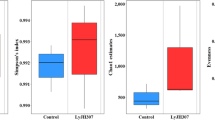Abstract
Many beneficial effects of probiotics have been reported; however, few have focussed on the effects of Lactobacillus, a probiotic, on the bioconversion of isoflavonoids. We hypothesized that Lactobacillus rhamnosus will modify the metabolism of isoflavone. In an in vitro incubation, L. rhamnosus JCM 2771 produced daidzein from daidzin along with genistein. However, daidzin and genistein were not detected in the incubation solution of daidzein with L. rhamnosus. In the fecal suspension from a male equol producer with daidzein, equol was detected in the presence of a low or high concentration of L. rhamnosus. In the fecal incubation with daidzin, the equol concentration increased with an increasing concentration of L. rhamnosus JCM 2771. L. rhamnosus affected the equol production in the in vitro incubation of daidzein with fecal flora from a male equol producer. We demonstrated for the first time that L. rhamnosus JCM 2771 could produce genistein from daidzin and affect the equol production of fecal flora from a male equol producer in vitro.





Similar content being viewed by others
References
Fuller R (1989) Probiotics in man and animals. J Appl Bacteriol 66:365–378
Usman, Hosono A (2000) Effect of administration of Lactobacillus gasseri on serum lipids and fecal steroids in hypercholesterolemic rats. J Dairy Sci 83:1705–1711
Wang AN, Yi XW, Yu HF, Dong B, Qiao SY (2009) Free radical scavenging activity of Lactobacillus fermentum in vitro and its antioxidative effect on growing-finishing pigs. J Appl Microbiol 107:1140–1148
Zanoni S, Pompei A, Cordisco L, Amaretti A, Rossi M, Matteuzzi D (2008) Growth kinetics on oligo- and polysaccharides and promising features of three antioxidative potential probiotic strains. J Appl Microbiol 105:1266–1276
Han RM, Tian YX, Liu Y, Chen CH, Ai XC, Zhang JP, Skibsted LH (2009) Comparison of flavonoids and isoflavonoids as antioxidants. J Agric Food Chem 57:3780–3785
Kelly GE, Joannou GE, Reeder AY, Nelson C, Waring MA (1995) The variable metabolic response to dietary isoflavones in humans. Proc Soc Exp Biol Med 208:40–43
Xu X, Harris KS, Wang HJ, Murphy PA, Hendrich S (1995) Bioavailability of soybean isoflavones depends upon gut microflora in women. J Nutr 125:2307–2315
Setchell KD, Borriello SP, Hulme P, Kirk DN, Axelson M (1984) Nonsteroidal estrogens of dietary origin: possible roles in hormone-dependent disease. Am J Clin Nutr 40:569–578
Tamura M, Ohnishi-Kameyama M, Shinohara K (2004) Lactobacillus gasseri: effects on mouse intestinal flora enzyme activity and isoflavonoids in the caecum and plasma. Br J Nutr 92:771–776
Larkin TA, Price WE, Astheimer LB (2007) Increased probiotic yogurt or resistant starch intake does not affect isoflavone bioavailability in subjects consuming a high soy diet. Nutrition 23:709–718
Hudson JA, Morvan B, Joblin KN (1998) Hydration of linoleic acid by bacteria isolated from ruminants. FEMS Microbiol Lett 169:277–282
Kishimoto N, Yamamoto I, Toraishi K, Yoshioka S, Saito K, Masuda H, Fujita T (2003) Two distinct pathways for the formation of hydroxy FA from linoleic acid by lactic acid bacteria. Lipids 38:1269–1274
Bowey E, Adlercreutz H, Rowland I (2003) Metabolism of isoflavones and lignans by the gut microflora: a study in germ-free and human flora associated rats. Food Chem Toxicol 41:631–636
Tang AL, Shah NP, Wilcox G, Walker KZ, Stojanovska L (2007) Fermentation of calcium-fortified soymilk with Lactobacillus: effects on calcium solubility, isoflavone conversion, and production of organic acids. J Food Sci 72:M431–M436
Pearson JR, Wiggins HS, Drasar BS (1974) Conversion of long-chain unsaturated fatty acids to hydroxy acids by human intestinal bacteria. J Med Microbiol 7:265–275
Coldham NG, Darby C, Hows M, King LJ, Zhang AQ, Sauer MJ (2002) Comparative metabolism of genistin by human and rat gut microflora: detection and identification of the end-products of metabolism. Xenobiotica 32:45–62
Tamura M, Nakagawa H, Ohnishi-Kameyama M, Tsushida T (2007) Dihydrogenistein-producing bacterium TM-40 isolated from human feces. Food Sci Technol Res 13:129–132
Hur HG, Lay JO Jr, Beger RD, Freeman JP, Rafii F (2000) Isolation of human intestinal bacteria metabolizing the natural isoflavone glycosides daidzin and genistin. Arch Microbiol 174:422–428
Newbold CJ, Williams AG, Chamberlain DG (1987) The in vitro metabolism of d, l-lactic acid by rumen microorganisms. J Sci Food Agric 38:9–18
Finegold SM, Attebery HR, Sutter VL (1974) Effect of diet on human fecal flora: comparison of Japanese and American diets. Am J Clin Nutr 27:1456–1469
Counotte GH, Prins RA, Janssen RH, Debie MJ (1981) Role of Megasphaera elsdenii in the fermentation of dl-[2-C]lactate in the rumen of dairy cattle. Appl Environ Microbiol 42:649–655
Kabel MA, Kortenoeven L, Schols HA, Voragen AG (2002) In vitro fermentability of differently substituted xylo-oligosaccharides. J Agric Food Chem 50:6205–6210
Hashizume K, Tsukahara T, Yamada K, Koyama H, Ushida K (2003) Megasphaera elsdenii JCM1772T normalizes hyperlactate production in the large intestine of fructooligosaccharide-fed rats by stimulating butyrate production. J Nutr 133:3187–3190
Minamida K, Tanaka M, Abe A, Sone T, Tomita F, Hara H, Asano K (2006) Production of equol from daidzein by gram-positive rod-shaped bacterium isolated from rat intestine. J Biosci Bioeng 102:247–250
Acknowledgments
This study was financially supported by a Grant-in-Aid for Scientific Research (C) from the Japan Society for the Promotion of Science.
Author information
Authors and Affiliations
Corresponding author
Rights and permissions
About this article
Cite this article
Tamura, M., Hori, S. & Nakagawa, H. Lactobacillus rhamnosus JCM 2771: Impact on Metabolism of Isoflavonoids in the Fecal Flora from a Male Equol Producer. Curr Microbiol 62, 1632–1637 (2011). https://doi.org/10.1007/s00284-011-9904-6
Received:
Accepted:
Published:
Issue Date:
DOI: https://doi.org/10.1007/s00284-011-9904-6




